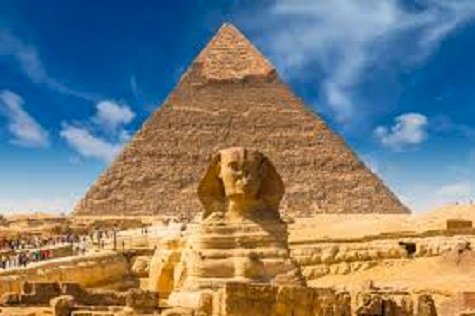Egypt and the Mystery of the Pyramid
The Egyptians built the pyramids as tombs for their kings, or pharaohs. Egyptian beliefs held that when the pharaoh died, his spirit remained vital in the afterlife.

The Egyptian pyramids are one of the outlining architectural achievements of the ancient world. As an incredible achievement of work, Egyptologists are still discovering more about these structures with each passing year.
The Giza pyramid complex has drawn Tourist from around the world since the days of the Grand Tour and children around the world who study the mysteries of ancient Egypt can’t help but associate the pyramids with the grand pharaohs of yesteryear. Still shrouded in mystery, the pyramids don’t reveal their secrets easily. But over time, scholars have come to learn many surprising facts about ancient Egypt through them. Technical prowess mixed with mythology and superstition led the pharaohs to construct these formidable structures, which have proven to be some of the most indestructible pieces of architecture ever created. So while you think you may have learned all you need to know about the Egyptian pyramids there’s a lot left to discover.
Why was the Pyramid Created?
The Egyptians built the pyramids as tombs for their kings, or pharaohs. Egyptian beliefs held that when the pharaoh died, his spirit remained vital in the afterlife. Part of his spirit, known as ka, needed an earthly home. Preserving the pharoah’s body in the pyramid ensured survival of his ka, which would allow him a happy existence in the afterlife, and his people protection from disaster. In addition to the pharoah’s body, the pyramids contained food, furniture and other items the pharaoh would need in the afterlife.
The pharoah reached heaven via sunbeams, so the pyramids contain shafts leading up from the burial chambers that may have been designed to help the king’s spirit reach the heavens. The shape of the pyramids themselves may have been designed to evoke the rays of the sun streaming between heaven and earth. The great pyramids at Giza have another connection to the heavens – they are large enough to be viewed from outer space and are clearly identifiable on satellite photos.
The pharoahs’ tombs didn’t stand alone. Instead, they were part of a complex of structures that included mortuaries, temples, smaller pyramids and tombs of officials in the pharoah’s government. Workers often lived in villages constructed near the pyramids. Excavations have revealed that these workers were not slaves, but skilled craftsmen who specialized in stone carving and other techniques employed in building the pyramids.
Architectural, Significance and Mystery of the Pyramid
All pyramids aren’t created equal. In fact, just as with many building types, there are distinct phases to pyramid construction. The earliest pyramids aren’t the pointed structures we most commonly think of but were actually flat.
Many examples are found in the vast Saqqara burial ground located in what was Ancient Egypt’s capital, Memphis. The pyramids here are the earliest known and include the Pyramid of Djoser. Built during the third dynasty and designed by architect Imhotep, it was constructed between 2630 BCE and 2611 BCE. It’s considered one of the world’s oldest monuments made of cut masonry and is not, in fact, pointed.
One of the biggest mysteries about the Egyptian pyramids is the construction techniques used to erect them. The incredible feat of the Egyptians is all the more impressive when taking into consideration that over 2 million limestone and granite blocks were used to build the Great Pyramid of Giza. Each piece of masonry weighed about 2.5 tons (2.3 metric tons).
Archeologists have identified about 80 pyramids in Egypt, some little more than foundations. The Great Pyramid at Giza is the largest, rising 481 feet above the desert. Builders used 2.3 million stone blocks to construct this pyramid; each block weighs between 2.5 and 1.5 tons. The first pyramids were constructed of stair-stepped stone. Over time, builders moved to the classic pyramid shape. Scientists don’t know why Egyptians stopped building pyramids, although it may have been that the cost of construction became prohibitive.
So how were these giant blocks moved? Unfortunately, the Egyptians didn’t leave behind written records, and many theories have been proposed over the years. A 2014 study theorized that it could be as easy as water and sand. A wall painting dating back to 1900 BCE depicts a procession of men pulling a large statue on a sled as one person stands at the front pouring water over sand. Though it was originally thought that the gesture was purely ceremonial, there is scientific evidence that this painting holds the key to unlocking the mystery of how they moved all that weight.
According to a British Egyptologist, the stars were a guiding force in how the pyramids were aligned. Kate Spence of Cambridge University published research in 2000 that demonstrates how the Big Dipper and Little Dipper were used to align the pyramids in a north-south direction.
So accurate were their measurements that they only have a margin of error of up to 0.05 degrees. Interestingly, with this information in hand, it’s possible to date the pyramids using astronomical records.
Ancient Egyptian culture is full of symbolism and superstitions that guided decision making. So it should come as no surprise that even the location of the ancient pyramids were guided by mythology.
Most were built on the west bank of the Nile, and for a distinct reason. As the pyramids were the final resting places of pharaohs, it only makes sense they should reside where their souls can begin their journey into the afterlife. For ancient Egyptians, the afterlife and the sun were closely intertwined. Osiris, an Egyptian god closely connect with the afterlife, represented the strength of new life. Over time, he also became associated with the cycle of the sun and how it brought new growth from dormant seeds.
Thanks to this association, the setting sun came to symbolize death and the sun “died” in the west each night. The souls of the pharaohs were meant to connect with the setting sun before rising again in the morning, a symbol of eternal life. By placing pyramids to the west of the Nile, they lived right in the area that metaphorically signified death.
Egyptology is a highly active field, with researchers moving away from reading inscriptions, but continuing to excavate and use technology to answer the many mysteries still left to be revealed. For instance, the recent discovery of a 4,500-year-old ramp north of Luxor is giving scholars clues into how the ancient Egyptians may have hauled masonry long distances.
Close to the Saqqara burial site, the discovery of cat mummies and hundreds of wooden cat statues in a tomb also show just how much there still is to explore and uncover about the Ancient Egyptians.
The Great Pyramid of Giza is not only the most recognized of Egypt’s pyramids; it’s also the only of the Seven Wonders of the Ancient World that’s still standing. The Great Pyramid is impressive for many reasons, but one of the most interesting characteristics of this celebrated monument is that it can also tell time. The structure actually acts as an enormous sundial, with its shadow telling the hour by falling on marks made in the stone.
Of course, being the Great Pyramid, it couldn’t be just any old sundial. Its level of sophistication meant that it not only told time, but was able to signal solstices and equinoxes and therefore helped the Egyptians define the solar year.
REFERENCE
Ancient Egypt: Pyramids
By Cynthia Myers
Courtesy Leaf Group USA Today
What's Your Reaction?

























